224th Airborne Medical Company Unit History
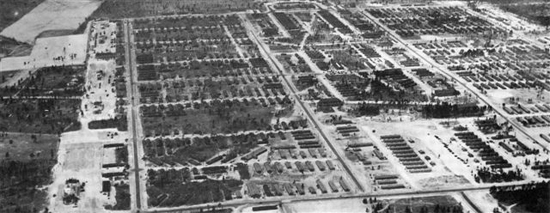
Aerial view of Camp Mackall, Hoffman, North Carolina. This is the place where the 224th Airborne Medical Company was officially activated 15 April 1943. (Cp. Mackall was spread over 61,971 acres, and had a troop capacity of 2,640 Officers and 27,000 Enlisted Men).
Activation & Introduction:
The 224th Airborne Medical Company was formally activated on 15 April 1943, as an organic part of the 17th Airborne Division (also activated 15 Apr 43 –ed), at Camp Mackall, Hoffman, North Carolina (Airborne Center, troop capacity 2,640 Officers & 27,000 EM –ed), by the Commanding General, Second United States Army, according to War Department, The Adjutant General, Washington, D.C., Letter, File AG 320.2 (dated 25 Dec 43), Washington, D.C., The Adjutant General, File 320.2 (dated 14 Jan 43), OB-I-GN-M, dated 19 January 1943, and Letter War Department, The Adjutant General, Washington, D.C., File AG 320.2 (dated 6 Mar 43), OB-I-GBGCT-M, dated 9 March 1943, same Subject.
The enlisted cadre, furnished by the 101st Airborne Division, arrived 8 March 1943 and was temporarily attached to the Cp. Mackall Station Complement pending the activation of the Division. The Officer cadre came from the 88th Infantry Division, Camp Gruber, Braggs, Oklahoma (Division Camp –ed), and arrived a few days later after attending a course in “Glider Tactics” at the Airborne Command School, Laurinburg-Maxton Army Air Base (Troop Carrier & Glider Training Center, activated 28 Aug 42 –ed), and the “Cadre School” at Carlisle Barracks, Carlisle, Pennsylvania (Medical Field Service Training School –ed). After arrival of the selectees on 10 April 1943, Basic Training was begun on 3 May 1943 and completed on 7 August 1943.
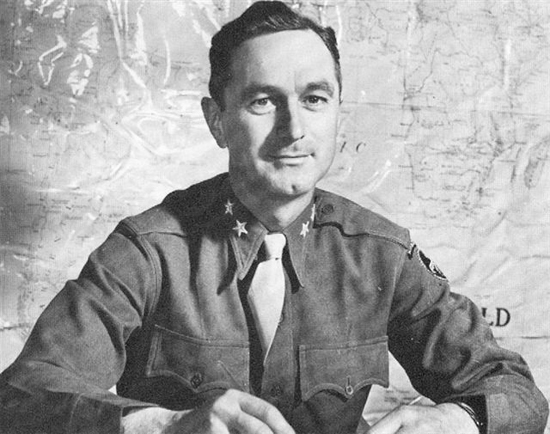
Picture of Major General William M. Miley, CG 17th Airborne Division (26 December 1897 – 28 September 1997).
Training:
Full Unit training period commenced on 8 August 1943 and continued through 13 November 1943. During this period emphasis was given to technical training, loading, lashing, and orientation flights in CG-4A gliders and C-47 cargo aircraft. Field problems, both day and night (under blackout conditions) were included. Training with the different combat teams occupied most of the period from 14 November 1943 to 1 January 1944. During this period the Company participated in Regimental and Divisional exercises varying in length from one day to one week. Both actual and simulated casualties were evacuated.
The period from 2 January 1944, plans were laid down for participation in several Maneuvers (Tennessee Maneuvers and Second Army No. 5 Maneuvers Feb 44 –ed) and the general Airborne Maneuvers which began on 24 March 1944.
Organization:
The Commanding Officer of the 224th Airborne Medical Company during all engagements was Major James J. KENNY, O-389250, MC. The C.O. was transferred to the 82d Airborne Division on 1 July 1945, and replaced by Major Jerry J. BELDEN, O-375276, MC (former CO > 307th Airborne Medical Company –ed).
The original T/O 8-37, dated 5 September 1942, authorized 21 Officers and 195 Enlisted Men. In June 1944 a change in T/O was introduced authorizing 21 Officers and 187 EM.
On 16 December 1944, the T/O changed again expanding the Company to 27 Officers and 273 Enlisted Men. The change was authorized under T/O & E 8-87-T, dated 16 December 1944, effective at 0001, 1 March 1945, per Letter Order, Headquarters, 17th Airborne Division, File 332 (AG), Subject: Reorganization of 17th Airborne Division, dated 28 February 1945.
At intervals during the campaigns in the European Theater of Operations, various units were temporarily attached to the Division and ordered to duty with the 224th Airborne Medical Company.
Attached Units
The 419th Medical Collecting Company, Headquarters & Headquarters Detachment, 65th Medical Group, was attached to the 17th Airborne Division, effective 18 January 1945, per troop assignment No. A-93, Headquarters, Third United States Army, dated 20 January 1945.
First Platoon, 623d Medical Clearing Company then serving with the 103d Evacuation Hospital was attached to the 17th Airborne Division, effective 20 January 1945, per troop assignment No. A-95, Headquarters, Third United States Army, dated 24 January 1945. The Platoon reported for duty 19 January 1945 and was already in operation on 22 January. It was relieved and attached to the 107th Evacuation Hospital on 10 February 1945, per troop assignment No. A-104, Headquarters, Third United States Army.
General Surgical Team No. 3, 4th Auxiliary Surgical Group (consisting of 3 Off & 2 EM) and General Surgical Team No. 10, 1st Auxiliary Surgical Group (consisting of 3 Off & 2 EM), were attached to the 17th Airborne Division, effective 8 March 1945, per troop assignment No. 6, Headquarters, XVIII Airborne Corps, File 332 (AG) dated 14 March 1945. Both Teams reported for duty 13 March 1945, and were relieved after operation by troop assignment No. 7, Headquarters, XVIII Airborne Corps.
First Platoon, 224th Airborne Medical Company, was relieved from assignment to the 17th Airborne Division and attached to the 13th Airborne Division, effective 14 July 1945, under authority of GNMTE, Commanding General, XVI Corps.
Platoons of the 429th Medical Collecting Company, the 459th Motor Ambulance Company, and the 499th Motor Ambulance Company were attached to the 17th Airborne Division in January 1945 (no accurate records available).
| Unit Strength | ||
| Date | Officers | Enlisted Men |
| 1 May 1943 | 11 | 243 |
| 1 June 1943 | 9 | 247 |
| 1 July 1943 | 11 | 224 |
| 1 August 1943 | 12 | 216 |
| 1 September 1943 | 12 | 213 |
| 1 October 1943 | 14 | 206 |
| 1 November 1943 | 14 | 202 |
| 1 December 1943 | 13 | 202 |
| 1 January 1944 | 14 | 196 |
| 1 February 1944 | 15 | 201 |
| 1 March 1944 | 12 | 201 |
| 1 April 1944 | 12 | 203 |
| 1 May 1944 | 17 | 204 |
| 1 June 1944 | 25 | 197 |
| 1 July 1944 | 24 | 201 |
| 1 August 1944 | 23 | 191 |
| 1 September 1944 | 21 | 187 |
| 1 October 1944 | 22 | 227 |
| 1 November 1944 | 22 | 227 |
| 1 December 1944 | 24 | 225 |
| 1 January 1945 | 23 | 220 |
| 1 February 1945 | 24 | 216 |
| 1 March 1945 | 28 | 216 |
| 1 April 1945 | 26 | 235 |
| 1 May 1945 | 23 | 260 |
| 1 June 1945 | 31 | 258 |
| 1 July 1945 | 16 | 210 |
| 1 August 1945 | 23 | 221 |
| 1 September 1945 | 22 | 300 |
| 16 September 1945 | 22 | 299 |
Roster of Key Officers
Major James J. Kenny, MC, Commanding Officer
Captain Arthur M. Hetzer, MC, Executive Officer
Captain Alan S. Pritchard, DC, Records Section Officer
1st Lieutenant Charles H. Waste, MAC, Medical Supply Officer
Captain Frank Parisi, MC, Commanding Officer, First Platoon
Captain Elwood H. Heilman, MC, Commanding Officer, Second Platoon
Captain Malcolm G. Heath, MC, Commanding Officer, Third Platoon
Captain James V. Valerio, Jr., MC, Commanding Officer, Treatment Section, First Platoon
Captain Thomas A. Shaffrey, MC, Commanding Officer, Treatment Section, Second Platoon
Captain Earnest B. Carpenter, MC, Commanding Officer, Treatment Section, Third Platoon
Captain Hector M. Nadal, MC, Commanding Officer, Ward Section, First Platoon
Captain Robert E. Moylan, MC, Commanding Officer, Ward Section, Second Platoon
Captain Hideo H. Kato, MC, Commanding Officer, Ward Section, Third Platoon
1st Lieutenant Peter DeVries, MAC, Evacuation Officer, First Platoon
1st Lieutenant Paul W. Robinson, MAC, Evacuation Officer, Second Platoon
1st Lieutenant Edward L. Kirkpatrick, MAC, Evacuation Officer, Third Platoon
Preparation for Overseas Movement:
The 224th Airborne Medical Company moved as an organic unit of the 17th Airborne Division from Cp. Mackall, North Carolina, per First Indorsement to Letter, Subject: “Clearance of Camp Mackall, N.C.”, dated 8 February 1944, and authorized by The Adjutant, Camp Mackall, authorized by Headquarters, Second United States Army, Letter AG-370.5-5-464 (Feb 43), 11 January 1944. The Company departed on 7 February 1944 and closed in its new area 10 February 1944.
The unit was with the 17th Airborne Division during the Tennessee Maneuvers No. 5 and saw active service in operations #2-8 from 14 February 1944 to 23 March 1944. It departed Cp. Forrest, Tullahoma, Tennessee (Infantry Division Camp –ed) on 24 March 1944, closing there on 26 March. After leaving Cp. Forrest on 10 July 1944, the Company transferred to Cp. Myles Standish, Boston, Massachusetts (Staging Area for the Boston Port of Embarkation –ed) on 12 August 1944 by authority of Special Order No. 159, Paragraph 11, Headquarters, 17th Airborne Division, dated 22 July 1944.
United Kingdom:
The 224th A/B Med Co departed 16 August 1944, landing at Liverpool, United Kingdom, on 26 August 1944, and closed in the Division Area at Camp Chiseldon, England on 26 August 1944.
France:
Following the outbreak of the German Counteroffensive in the Belgian Ardennes on 16 December 1944, and as a result of the further evolution of the enemy breakthrough, the 17th Airborne Division was flown to the Reims area between 23 and 25 December 1944 by emergency night flights and assembled at Mourmelon. Movement from Mourmelon to Charleville (France) was made by motor convoy preparatory to moving into defensive positions during the Ardennes Campaign. The 224th departed Camp Mourmelon on 24 December 1944, closing in the new area 28 December 1944. Roads were poor and the weather clear and cold. Charleville became the Company’s new station. The Division had been instructed to defend part of the Meuse River from Givet to Verdun, France.
Belgium – Grand-Duchy of Luxembourg:

Major General William M. Miley presents awards to troops of the 17th A/B Division after the Bulge Campaign (Belgian Ardennes).
Further movement was made from Charleville, France to Neufchâteau, Belgium (where they set up in a requisitioned civilian hospital –ed). The move was made in direct support of the 17th Airborne Division which was to relieve the 28th Infantry Division by 1 January 1945. One Collecting Platoon proceeded to Bercheux, Belgium to establish a Collecting Point at Jodenville. The Company departed 1 January by truck and ambulance convoy and completed the move the following day. Roads were fair, the weather was cold and it snowed.
From Neufchâteau, a series of further moves took place by truck and ambulance, during which the various Platoons leapfrogged giving continuous medical support to the steadily advancing divisional troops. The Company departed Neufchâteau, Belgium on 4 January, and closed at Wiltz, Grand-Duchy of Luxembourg, on 28 January 1945. The 635th Medical Clearing Station (set up in the area) was visited by the 224th’s XO in connection with casualty reports and progress of trench foot cases. On 9 January 1945 the Company received some additional support from a section of litter bearers provided by the 429th Medical Collecting Company. One advanced Collecting Platoon was set up at Amberloup, Belgium on 15 January, while a Collecting Point was established at Les Jardins, Belgium on 16 January 1945. Regimental Collecting Points were established in all Regiments save for the 513th PIR. The Company’s next forward station became Bertogne, in Belgium, which was established on 17 January. The reserve Platoon went to Longlier. The 623d Medical Clearing Company dispatched one its Platoons to Houffalize 22 January. Wiltz, in the Grand-Duchy of Luxembourg was the Company’s last station (it was set up in billets). On 27 January, the Company was relieved by the Clearing Station of the 87th Infantry Division. Between 29 January and 6 February 1945, the Company was held in reserve, troops received time for rest and rehabilitation. The roads were poor, the weather was cold, and there was windblown snow.
France:
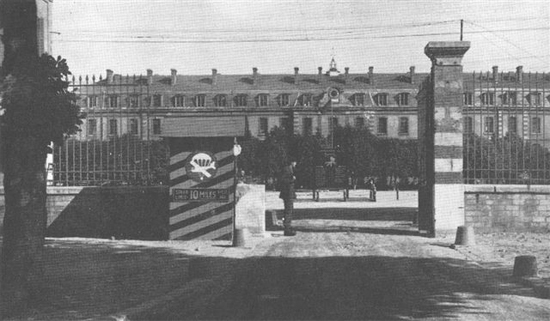
Front view of the 17th A/B Division Headquarters at Châlons-sur-Marne, France. Picture taken early March 1945.
Having completed its mission the 224th Airborne Medical Company returned with the Division to its assembly area at Châlons-sur-Marne, France to prepare for an important Airborne mission. An advance party under command of Captain Arthur M. Hetzer (XO) left on 7 February. The personnel departed Wiltz, moving by truck and ambulance 10 February 1945. It reached Châlons-sur-Marne 12 February. Roads were fair, and the weather was cool. Movement by truck from the assembly area at Châlons-sur-Marne to the take-off airfields prior to Operation “Varsity” took place on 21 March 1945. The next destination, Chartres, was reached by 22 March. Roads were good and the weather clear.
Germany:
After the successful airborne assault north of Wesel, Germany, a series of leapfrogging moves took place during which the 224th maintained a Clearing Station and Medical Collecting Points continuously in support of the 17th Airborne Division. The Company departed Wesel 27 March 1945 (the Company’s station was Peddenburg) and traveled to Münster, Germany, where it arrived 4 April 1945. The movement was effected by truck and ambulance convoy (4 ambulances arrived from the 459th Motor Ambulance Company, 7 from the 499th Motor Ambulance Company and 8 from the 588th Motor Ambulance Company). All vehicles were later relieved and collected. Roads varied from poor to excellent. The weather was clear and warm.
From Münster leapfrogging continued by truck and ambulance convoy with the advancing Division. 17th Airborne troops were advancing rapidly through the Ruhr. Due to the continuous movement of troops, the Clearing Station could not open and therefore all Division casualties were directed to the 79th Infantry Division Clearing Station located nearby. The Company departed Münster 7 April reaching Oberhausen, Germany, on 11 April 1945. On 17 April 1945, Captain Thomas A. Shaffrey (CO > Treatment Section, 2d Platoon) visited and inspected a DP Camp north of Essen, Germany. The Division Surgeon being on leave at the French Riviera, Major James J. Kenny assumed duties of 17th Airborne Division Surgeon, and Captain Arthur M. Hetzer, XO, took over as acting Company Commander. The Company received 19 replacements on 20 April. Between 22 April and 30 April 1945, the Company had only 1 Platoon in operation. Division casualties were extremely light and most of the time was devoted to treating DPs and civilians. During the same period, the 224th conducted a School for Infantry soldiers with the purpose of teaching them medical aid. Roads were good, weather was rainy.
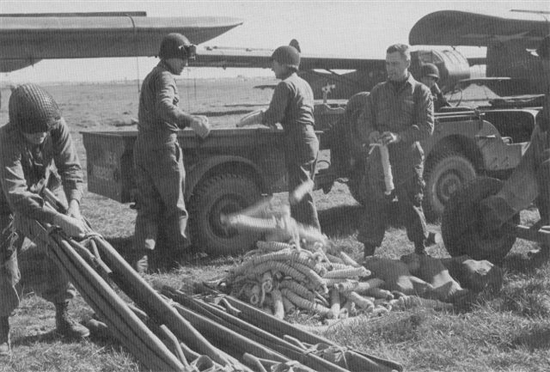
Miscellaneous equipment, including litters, being readied for “Operation Varsity – 24 March 1945.
France:
Having spent a certain period in Germany, it was now time to return to France. The 224th Airborne Medical Company left Oberhausen, Germany, 11 June 1945, traveling by rail and road to a new assembly area. The unit reached Vittel, France after a 4-day journey. The roads were good and the weather warm and clear.
After spending almost two and one-half months at Vittel, the Company received its marching orders for a new destination. The organization moved from the Vittel-Epinal assembly area to the St. Victoret Staging Area, near Marseille, Southern France. The movement commenced 30 August, with the troops closing at St. Victoret, 31 August 1945. Roads were good and the weather rainy. It remained at its new station (St. Victoret) until its departure for the Zone of Interior. Once back in the States, the new station became Camp Myles Standish, Massachusetts. The date was 15 September 1945.
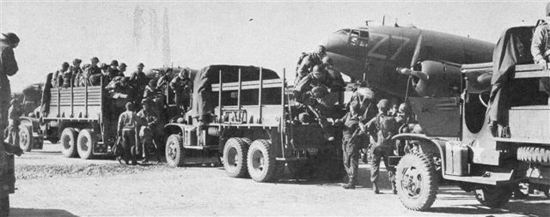
17th A/B Division personnel detruck at the marshaling area, where they will board the C-47 and new C-46 aircraft for the Rhine crossing jump.
Personnel Roster: (incomplete)
| Ackerley, Delmar Adams, Warren Adkins, Melvin L. Ailer, Robert R. Alvarez, Rufus G. Amberson, Merrill W. Amstutz, David D. Anderson, John R. Atkinson, Chelsea A. Aucoin, Clarence Austin, Ralph Baldwin, William I. Banker, Alfred G. Barnes, Robert W. Barron, James C. Jr. Batts, William D. Bauman, Jerome H. Beasley, William J. Bell, Chester W. Bellman, Leonard C. Benbrook James A. Bender, Eugene J. Bender, Sidney Benton, Lonnie E. Birkhofer, Howard E. Birnbaum, David Blommer, Earl F. Boettner, Siegfried Bowhay, Harold C. Brangan, William F. Jr Breeden, Richard G. Brennan, Francis J. Brison, Edward V. Brouhard, Jack S. Brown, Melvin F. Brown, Ray O. Browning, James I. Brunsman, Robert P. Bullen, Benjamin W. Burchett, James W. Bush, David N. Butler, William F. Canela, Manuel Y. Canfield, Francis C. Carlomagno, Joseph Carpenter, Earnest B. Carroll, Albert G. Caruso, Joseph A. Caruso, Vincent A. Case, William E. Casselman, Ken S. Childress, Billie C. Church, Ernest E. Cooney, James E. Crisp, James K. Crossley, Joseph E. Crowley, William E. Crum, Sol Jr. Cutsler, Thomas B. Cooper, James A. Corpus, Lawrence G. Cotter, Harry E. Crandall, Lawrence E. Daniels, Frank Davis, Wilbur L. Dean, Albert C. Dean, Inscho W. Dear, William DeBoy, Lawrence A. Decker, Ray E. DeMott, James P. Dennis, Leonard T. Denny, Noel B. Depaulo, Herman D. DePerrro, Salvatore R Desvouges, Herman L. De Vries, Peter Diab, George Divan, Dorn J. Dobbins, James A. Dudley, Robert E. Dunham, Ralph M. Edwards, Francis L. Egan, Kenneth E. Egan, James E. Engholm, Bernhardt G. Ennis, Woodrow F. Evers, Clarence N. Fabian, John D. Farese, Peter B. Fearneyhough, Ralph W. Fedorcha, Thomas A. Fietz, Lawrence H. Filson, Richard T. Firestein, Wallace C. Firment, Joseph A. Fisher, Francis W. Fitler, William H. Fitts, Willie F. Foutch, Virgil Fowler, John F. Fox, Ralph G. Foxman, Paul B. Free, Charles H. Freeman, Arthur M. Frezza, Albert Frenette, Anthony P. Galindo, Alex H. Gannaway, Emmett A. Gedney, Donald E. Georgeff, Basil B. Gibson, David L. Gibson, Everett E. Gillespie, Dale E. Goldstein, Albert Goldstein, Meyer H. Gordon, Frank W. Gornik, Joseph V. Gregory, Benjamin F. Gross, Jerome S. Guarnieri, James C. Guest, John W. Guiroga, Louis Gulik, Mitchell J. Gunderman, Harry P. Gurley, Julius D. Gustock, John J. Hadley, Gerald M. Hall, Clarence A. Hall, Murray B. Hall, Roy A. Jr. Hanna, Benjamin D. Hanna, Thomas R. Haugen, Gordon R. Hayes, James C. |
Heath, Malcolm G. Hecht, Lothar L. Heck, William E. Heilman, Elwood H. Hensley, Arlie A. Heslep, Dewey E. Hess, John Jr. Hess, Robert B. Hetzer, Arthur M. Hilburn, Edward Jr. Hill, Ether C. Jr. Hitchcock, Lewis C. Holmes, John F. Houghton, Walter L. Houser, Cecil H. Hubard, Robert K. Jr. Hudson, Charles A. Hughes, George W. Humble, John L. Hunt, James W. Hunt, William G. Hurd, Ray E. Jacoby, Charles T. James, Curt O. Jandron, John H. Johnson, James D. Johnson, Kenneth L. Johnson, Samuel H. Johnson, Walter M. Jones, Edwin L. Jones, Raymond E. Jones, William I. Jr. Kachinarz, Stanley J. Kahn, Joseph W. Kalchuk, John Kane, Miles P. Kato, Hideo H. Keating, John E. Keel, Andrew C. Jr. Kelly, Kelly, L. Kelly, Robert L. Kenny, James J. Kinney, Virgil J. Kirkpatrick, Edward L. Kirschler, Albert A. Knecht, Arthur W. Knopp, Francis S. Knotts, Kenneth I. Kohute, Edward G. Komar, Robert E. Koury, James M. Kubes, Gilbert W. Kuebler, Herbert A. Lacharite, Lucien W. Lainbert, Carmon B. Lamertina, Joseph S. Laquitara, William P. Larimer, Clarence H. Lawson, John E. Leahy, James D. Lee, James C. Leonardo, Joseph Jr. Lessans, Seymour Lichner, Joseph Light, Ralph K. Lillie, Francis E. Lindsay, George E. Jr. Lister, Alexander E. Littman, Sam Lockard, Lyle J. Lord, Emory L. Love, Richard L. Lower, John J. Lupoli, Joseph F. Lynch, Vear Mack, John F. Madden, Maurice F. Magee, Frank N. Magner, Thomas C. Magnuson, Warren B. Mahokin, Michael Majka, Chester, J. Malacarne, Andrew A. Marivittori, Valeo J. Marmiroli, Alexander Masterson, James H. Matlow, Philip May, William L. McCabe, Edward B. McClimans, Paul A. McCormick, John L. McCotter, Hugh B. McCrory, Charles F. McDaniel, William J. McDonnell, James H. McDowell, James G. McLain, William H. McSparron, W. J. Jr. Mellon, Thomas J. Mellone, Paul Meshell, Elmer R. Mestrich, Joseph Metrick, William Mierisch, Walter O. Miget, Stephen P. Mitchell, Reece Montanari, Duilio A. Moore, William B. Morgan, Everett A. Motsinger, Gerald E. Moyer, Homer C. Moylan, Robert E. Moynihan, Andrew A. Mulholland, Francis H. Munza, Vincent W. Murphy, Thomas A. Nadal, Hector M. Naro, Ross J. Nichols, Dean D. Nobrega, Herbert A. Nordblum, Theodore Q. Norred, Arthur E. Novak, Albin F. O’Brien, Philip Jr. O’Connor, Francis P. Odom, Jefferson D. O’Donnell, Warren E. Olson, Victor E. O’Neill, John J. O’Neill, William J. Jr. Onufrak, Michael A. Ortega, Marcello Pack, Ernest W. Jr. Paddock, Robert F. Padish, Andrew P. |
Panek, Ludwik Parkes, Howard F. Parrish, Oscar L. Patelski, Leo F. Perkins, Lawrence W. Piccolo, Carmine D. Porter, Thomas B. Posner, George Pratt, Willis B. Press, Gordon R. Price, Irwin S. Price, Shelton Pritchard, Alan S. Putnam, Lyle B. Quiett, James E. Quigley, Robert L. Quigley, William J. Quinn, Donald W. Quon, Jew F. Ramshaw, Robert J. Reck, Arthur C. Reilly, Enos J. Rhinelander, John G. Ritchey, Bill H. Robinson, Arza M. Robison, Newell G. Robison, Paul W. Rollison, Ernest W. Rooney, Leo J. Rose, Joseph E. Rothenbuecher, Robert Rothgeb, William C. Rowand, Richard C. Rudd, Howard S. Scaglione, Joseph A. Scaglione, Vincent P. Schall, Jerome W. Scherer, George A. Schmidt, William Schott, Wilbur Scott, William A. Sebastian, Harold J. Seitz, Donald L. Sepick, John J. Shaffrey, Thomas A. Shapiro, Arnold Sharp, Bernice W. Sharpe, William H. Shea, John J. Sheffer, Virgil R. Shepard, Earl W. Sheridan, James E. Shindley, Harold L. Shortsleeve, Jack L. Shrum, John W. Simmons, James R. Smart, Meryl G. Smith, Dale M. Smith, Earl R. Smith, Henry J. Smith, Joseph F. Smith, Robert A. Smith, Robert J. Smith, Stanley F. Smylie, William S. Sorce, Stephen Sparks, Paul R. Spears, Douglas S. Spencer; Byron L. Spidle, Eldor F. Stacy, Malen C. Stanley, James C. Stanton, Francis R. Stark, Harold E. Stern, Edward A. Stern, John A. Steven, George T. Stinson, Arthur G. Stowers, Alexander T. Strandell, Alex C. Strelsin, Abe Stringer, Arthur E. Jr. Stroyick, Charles L. Sutherland, James A. Swain, George T. Jr. Sweet, Robert E. Tannehill, James R. Tate, John M. Taylor, Edward M. Thompson, C. J. Jr. Tinsley, Ercil C. Tominey, Patrick J. Tooley, Lloyd C. Tucker, Bobby L. Tucker, Charley G. Tuckey, Earl W. Tudor, John P. Turner, Guy M. Turner, Kenneth E. Tweed, Joseph P. Uzelac, Edward D. Valerio, James V. Jr. Varcoe, James H. Jr. Vardanian, Norman Versprella, Eugene G. Vichot, John J. Vryhof, Wesley Wagen, Raymond F. Walden, Chester H. Walker, Ralph L. Waste, Charles H. Watson, Samuel G. Watts, Roger E. Webb, Edgar W. Weber, Paul Jr. Weiss, Joseph Welch, William A. Weldon, George A. Wesley, Walter F. Weyraugh, George White, Richard E. White, Robert L. Wientczak, Edmund A Wiesse, William S. Wilk, Joseph A. Williams, Arthur W. Witt, Jacob E. Woods, Lester R. Woolwine, Stanley J. Wray, Hugh I. Wylie, Jack Yeske, Alfred L. Young, Richard A. Zimmerman, Edwin G. Jr. |
Campaigns:
Ardennes-Alsace (official duration 16 Dec 44 – 25 Jan 45) and Rhineland (official duration15 Sep 44 – 21 Mar 45). From 2 January 1945 – 28 January 1945, the Company was engaged in the Battle of the Bulge. Its purpose was to provide medical support to the 17th Airborne Division during the Ardennes campaign.
At the onset of the German Counterattack in December 1944, in Belgium, the 224th Airborne Medical Company was stationed in England at Camp Chiseldon. It was alerted with the 17th Airborne Division and flown on 24 December to Mourmelon, France. Entering the Belgian Ardennes by truck the unit rendered direct medical support to the 17th Airborne Division during the entire Ardennes and Rhineland campaigns maintaining clearing stations, collecting points, and evacuation lines in spite of hazardous battle conditions and the most inclement weather. The skill and efficiency of the men of the 224th Airborne Medical Company made it possible for many troopers to live to fight another day.

224th Airborne Medical Company personnel use local carts and horses for transportation of casualties and supplies, during Operation “Varsity”.
Central Europe (official duration 22 Mar 45 – 11 May 45). From 24 March 945 to 8 May 1945, the Company was engaged in Operation “Varsity”. The purpose of this operation was to land troops by parachute and glider on DZs and LZs north of Wesel, Germany, commencing 24 March 1945, and to establish a clearing station in a pre-designated area within the 17th Airborne Division defense perimeter, and to collect, treat, and evacuate all casualties within that area. This was the first airborne operation to be conducted across the Rhine and into Germany itself.
For this operation, Special Order No. 1, Headquarters, 17th Airborne Division, dated 18 March 1945, divided the 224th Airborne Medical Company into 3 echelons:
Air Echelon
30 Officers
207 Enlisted Men
26 ¼-Ton Trucks
25 ¼-Ton Trailers
2 CG-4A Gliders with medical equipment and supplies
Overland Echelon
1 Officer
35 Enlisted Men
10 2 ½-Ton Cargo Trucks
12 ¾-Ton Ambulances
1 250-Gallon Water Tank Trailer
2 1-Ton Cargo Trailers
7 ¼-Ton Trucks
3 ¼-Ton Trailers
Base & Dispensary with Rear Echelon
2 Officers
9 Enlisted Men
2 ¾-Ton Ambulances
The corresponding planning and action program for the oncoming airborne operation were prepared by Lt. Colonel Edward Sigerfoos, MC, 17th Airborne Division Surgeon and included the following directions:
The Clearing Station site was picked by map and aerial photograph study and designated in the western part of LZ “N” (map coordinate 203464).
Organic ambulances of the 224th Airborne Medical Company were given high priority on river crossings.
Casualties were to be evacuated from the clearing stations to the far-shore holding units (under Army control) at 133420, thence by “Dukw” vehicles across the Rhine River. Plans for the evacuation of patients by glider pick-up were made with Troop Carrier Command (but none were used).
Two General Surgical Teams; Team No. 3 (4th Auxiliary Surgical Group), and Team No. 10 (1st Auxiliary Surgical Group), each consisting of 3 Officers and 2 Enlisted Men were attached to the 17th Airborne Division 11 days prior to D-Day. One (1) Medical Liaison Officer went to XVIII Airborne Corps and to DDMS, XII British Corps.
A “dry run” was held on surgical tents and equipment and specialized equipment obtained for the Surgical Teams (although they carried their own).
Personnel arrangements were made for Officers and Enlisted Liaisons as follows: 1 Officer and 3 EM each were to be attached to the 507th Parachute Infantry, the 513th Parachute Infantry, and the 194th Glider Infantry. Each Officer was furnished a ¼-ton truck. All personnel were to be glider-landed by the 194th GIR. Two (2) Enlisted Men would jump with the 513th PIR as Liaison personnel.
The equipment and personnel of the 224th Airborne Medical Company and the Division Surgeon’s Office was to be landed in a total of 53 CG-4A gliders. Twenty-six gliders would hold jeeps, twenty-five would transport 25 trailers, and two gliders were to be loaded to carry medical equipment only. Personnel would consist of 30 Officers and 270 Enlisted personnel. These figures included the 6 Officers and 4 EM of the Surgical Teams; 4 Officers and 4 EM of the Division Surgeon’s Office and the Division Chaplain.
Three (3) people would ride in jeep-gliders and 5 (up to 7) would accompany trailer-loaded gliders. Two (2) Medical Officers and 3 EM were assigned to the land-tail elements. One (1) Medical Officer and 3 EM remained with the rear echelon to operate a medical dispensary the other would join the unit on river crossings. Special troops, surgical and medical detachments were to remain at the Base Camp.
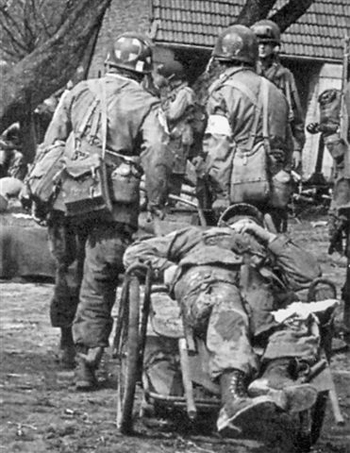
224th Airborne Medical Company personnel at work during “Operation Varsity”.
Normal supplies were to be carried in the combat load. Whole blood was delivered to the marshaling area on D-1. All non-medical gliders were to carry 1 additional litter and 2 wool blankets as extra supply. Special equipment was obtained for the Surgical Teams. All personnel were furnished with First-Aid Parachute Packets, Carlisle Dressings, Sulfadiazine Wound Tablets, and Motion Sickness Tablets.
The 224th Airborne Medical Company departed for its marshaling area 21 March 1945 where it arrived 22 March. The 17th Airborne Division Surgeon’s Office and staff departed for the area 22 March arriving on site the same day. The Company, the Division Surgeon’s staff, and the attached Surgical Teams were ready to depart on D-Day, 24 March 1945.

Illustration showing a Nazi flag captured by members of the 224th Airborne Medical Company. The flag has been signed by numerous soldiers, including some German Prisoners of War. Inset is a close-up photograph showing the signature of D. V. Tanico, Combat Medic.
Courtesy of Brett O’Grady.
Conclusion: taking off at 0915 hours, 24 March 1945, the Medical Company landed by glider at 1225 in the vicinity of Wesel, on LZ “N”. Within 55 minutes after landing in a fire swept field, the required Clearing Station was established and operational in the selected area. Personnel losses incurred during landing included 3 Medical Officers and 13 EM killed. Five (5) Officers and 34 EM were wounded. Casualties collected and treated during the first twenty-four hours totaled 394 (among which some 117 seriously wounded, 175 slightly wounded, and 33 injuries). Medical attention was provided to approximately 750 American and British casualties. A German medical unit was captured and set to work in an adjacent field to care for enemy wounded and were partially supplied with American equipment and supplies. German PWs were brought to the Clearing Station to dig foxholes and litter trenches for patients. Two ¼-ton trucks and four ¼-ton trailers containing rations, miscellaneous medical supplies, and one tent, were destroyed by enemy action. From H-Hour, 1225, 24 March 1945 until arrival of the overland echelon at 1000, 25 March 1945, definitive treatment, including major surgery, was done in the Clearing Station as from 1100, 25 March 1945. Contact with the ground forces was secure and normal evacuation of casualties across the Rhine River began only later as the ambulances were unable to cross the river and proceed to the Clearing Station (the far-shore HU was under control of a Platoon of the 643d Medical Clearing Company). Total casualties evacuated during the entire campaign numbered 3,042. It must be stated that the Company was always in close support of the different combat teams and rendered effective medical service and rapid evacuation in the field. 10 ambulances from the 488th Motor Ambulance Company and the 499th Medical Collecting Company arrived at noon on 27 March to assist in evacuation of the many casualties. The Clearing Station later moved to and opened in the vicinity of Peddenburg, Germany, after closing its previous Station. At 1800 hours, 28 March 1945, a new Station was established at Alt-Schermbeck. Enemy artillery air bursts totalling 8 to 10 rounds missed the Clearing Station by 100 yards, but there were no casualties. On 29 March, the Clearing Station leapfrogged to west of Haltern, Germany. On 31 March, the Clearing Station leapfrogged to 70 miles east of Dulmen, where it set up. All Clearing Stations were established under canvas.
The End:
The original First Platoon, 224th Airborne Medical Company was transferred to the 13th Airborne Division (arrived in France 6 Feb 45 –ed) on 5 July 1945 (effective 14 Jul 45), at Auxerre, France. A new unit was formed including the following elements:
First Platoon, 224th Airborne Medical Company
Medical Detachment, 194th Glider Infantry Antitank Company
Medical Detachment, 507th Parachute Infantry Regiment
Medical Detachment, 155th Airborne Antiaircraft Artillery Battalion
222d Airborne Medical Company, 13th Airborne Division
The unit’s strength was 8 Officers and 78 Enlisted Men. Losses by Discharge numbered 2 Officers and 25 EM. The 224th Airborne Medical Company departed Auxerre, France, for Camp “Twenty-Grand” (one of the Cigarette Camps –ed) 13 July 1945. It arrived on site at 1400 hours 16 July 1945. The Company departed the Camp at 1300, 4 August 1945, and embarked on the S/S James Jackson at 2100, the same day, with destination the Zone of Interior.
(the bulk of the 17th Airborne Division entrained for Marseille 7 September 1945, to board the S/S Wakefield and S/S Mariposa, bound for Boston, Massachusetts, and home –ed).
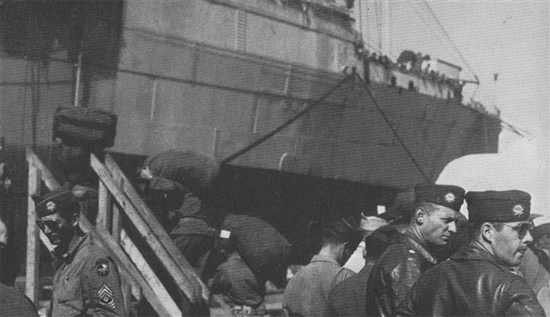
17th A/B Division personnel ready to embark on the S/S Wakefield, Marseille Port of Embarkation, Southern France, for return to the ZI. Picture taken 7 September 1945.
The ship arrived at New York harbor where the troops disembarked at 2100 hours, 22 August 1945. The following day the Company arrived at Camp Shanks, Orangeburg, New York (Staging Area for the New York Port of Embarkation –ed) which they reached early in the morning. The unit’s personnel was dispersed for recuperation of TDY on 24 August and reassembled at the Airborne Center, Camp Mackall, N.C., on 15 October 1945. The 224th Airborne Medical Company was finally inactivated 22 October 1945at Cp. Mackall, Hoffman, North Carolina.
The MRC Staff are truly indebted to Lynn F. McNulty who gratuitously provided them with some vintage reports relating to the 224th Airborne Medical Company, which helped them edit this Unit History.
